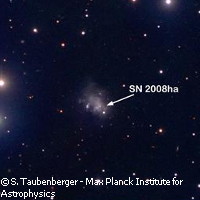Dim, hydrogen-poor supernova may help solve gamma-ray mystery
An international team of scientists has determined that a supernova called SN 2008ha, first observed in November 2008, is a faint, hydrogen-poor supernova. Their discovery, funded in part by the EU's Sixth Framework Programme (FP6), could link these events to a group of cosmic gamma-ray bursts, providing valuable insights into a long-standing mystery. The study is published in the journal Nature. Supernovae are stellar explosions that often indicate the sudden gravitational collapse of a star at least eight times the size of our Sun, and give rise to bursts of radiation so strong that they can briefly outshine a galaxy. Supernovae are classified into several types, which are determined by the profile of chemical elements that appear in their spectra. The presence or absence of hydrogen is an important factor in this classification. Stars going through gravitational collapse at the end of their lifetime form a black hole, at the same time ejecting their outer layers at an astoundingly high velocity: up to 10% of the speed of light. The energy released by such an explosion is more than the Sun has and will give off during its entire lifespan. An analysis of SN2008ha by researchers in the UK, Italy, Germany, Spain, Finland and the US showed that the explosion was around 100 times less energetic than usual. The scientists pooled their data on the event from the Calar Alto Observatory in Spain, the Telescopio Nazionale Galileo, Nordic Optical Telescope and Liverpool Telescope located in the Canary Islands, Spain and the Copernico Telescope in Italy. Their findings indicated that although low-energy, low-luminosity supernovae normally contain hydrogen, SN 2008ha did not. The lack of hydrogen is significant because it indicates that the star must have lost all its outer layers before the explosion took place. The researchers speculate that the dim, hydrogen-poor supernova's star may have been a moderately massive star in a binary system; in this scenario, the outer layers would have been lost through interactions between the companion stars. It is also possible that the progenitor star was very massive; its envelope could have been blown away by stellar winds before the core collapsed. In this scenario, the resulting black hole would vacuum up most of the radioactive material created during the supernova. Interestingly, the astronomers found very little evidence of radioactive material in the ejecta of SN 2008ha. If the very-massive-star scenario is true, SN 2008ha could help astronomers to understand better the connection between supernovae and a group of 'long' (lasting for several seconds) cosmic gamma-ray bursts. Astronomers have believed for some time that there is a connection between gamma-ray bursts and powerful supernova explosions, but in the past few years two long gamma-ray bursts have been detected which were not accompanied by very energetic and luminous supernovae. This seemed to indicate that the bursts might be associated with a type of dim supernova. However, until now, the dim supernova observed were always replete with hydrogen; in the presence of a hydrogen envelope, gamma-ray bursts are prevented from forming in the first place. 'The existence of hydrogen-deficient dim supernovae like SN 2008ha could now help to solve this puzzle,' said co-investigator Stefan Taubenberger of the Max Planck Institute for Astrophysics in Germany. 'Future observations of similar events will help us to understand whether they are a form of thermonuclear explosion, low-luminosity core-collapse supernovae from stripped stars of moderate mass, or the deaths of very massive stars inducing black-hole formation and fall-back,' the study concludes.



